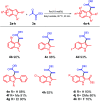Synthesis of α-indolylacrylates as potential anticancer agents using a Brønsted acid ionic liquid catalyst and the butyl acetate solvent
- PMID: 35493022
- PMCID: PMC9051412
- DOI: 10.1039/d0ra00990c
Synthesis of α-indolylacrylates as potential anticancer agents using a Brønsted acid ionic liquid catalyst and the butyl acetate solvent
Abstract
In this study, new α-indolylacrylate derivatives were synthesized by the reaction of 2-substituted indoles with various pyruvates using a Brønsted acid ionic liquid catalyst in butyl acetate solvent. This is the first report on the application of pyruvate compounds for the synthesis of indolylacrylates. The acrylate derivatives could be obtained in good to excellent yields. A preliminary biological evaluation revealed their promising anticancer activity (IC50 = 9.73 μM for the compound 4l) and indicated that both the indole core and the acrylate moieties are promising for the development of novel anticancer drugs. The Lipinski's rule and Veber's parameters were assessed for the newly synthesized derivatives.
This journal is © The Royal Society of Chemistry.
Conflict of interest statement
The authors declare that they have no competing financial interest.
Figures











Similar articles
-
1, 1'-Sulfinyldiethylammonium Bis (Hydrogen Sulfate) as a Recyclable Dicationic Ionic Liquid Catalyst for the Efficient Solvent-free Synthesis of 3, 4-Dihydropyrimidin-2(1H)-ones via Biginelli Reaction.Comb Chem High Throughput Screen. 2020;23(2):157-167. doi: 10.2174/1386207323666200127113743. Comb Chem High Throughput Screen. 2020. PMID: 31985368
-
Selected Drug-Likeness Properties of 2-Arylidene-indan-1,3-dione Derivatives-Chemical Compounds with Potential Anti-Cancer Activity.Molecules. 2021 Aug 30;26(17):5256. doi: 10.3390/molecules26175256. Molecules. 2021. PMID: 34500689 Free PMC article.
-
Synthesis, biological evaluation, drug-likeness, and in silico screening of novel benzylidene-hydrazone analogues as small molecule anticancer agents.Arch Pharm Res. 2016 Feb;39(2):191-201. doi: 10.1007/s12272-015-0699-z. Epub 2015 Dec 23. Arch Pharm Res. 2016. PMID: 26694484
-
Molecular Docking and In Vitro Anticancer Screening of Synthesized Arylthiazole linked 2H-indol-2-one Derivatives as VEGFR-2 Kinase Inhibitors.Anticancer Agents Med Chem. 2022;22(11):2166-2180. doi: 10.2174/1871520621666211118102139. Anticancer Agents Med Chem. 2022. PMID: 34792005
-
Green synthesis of coumarin derivatives using Brønsted acidic pyridinium based ionic liquid [MBSPy][HSO4] to control an opportunistic human and a devastating plant pathogenic fungus Macrophomina phaseolina.RSC Adv. 2022 Aug 24;12(37):23963-23972. doi: 10.1039/d2ra03774b. eCollection 2022 Aug 22. RSC Adv. 2022. PMID: 36093243 Free PMC article.
References
-
- Finefield J. M. Frisvad J. C. Sherman D. H. Williams R. M. J. Nat. Prod. 2012;75:812–833. doi: 10.1021/np200954v. - DOI - PMC - PubMed
- Shiri M. Chem. Rev. 2012;112:3508–3549. doi: 10.1021/cr2003954. - DOI - PubMed
- Shiri M. Zolfigol M. A. Kruger H. G. Tanbakouchian Z. Chem. Rev. 2010;110:2250–2293. doi: 10.1021/cr900195a. - DOI - PubMed
- Humphrey G. R. Kuethe J. T. Chem. Rev. 2006;106:2875. doi: 10.1021/cr0505270. - DOI - PubMed
- Bhadury P. S. Pang J. Curr. Org. Chem. 2014;18:2108–2124. doi: 10.2174/1385272819666140809010818. - DOI
-
- Fantacuzzi M. De Filippis B. Gallorini M. Ammazzalorso A. Giampietro L. Maccallini C. Aturki Z. Donati E. Ibrahim R. S. Shawky E. Cataldi A. Amoroso R. Eur. J. Med. Chem. 2020;185:111815. doi: 10.1016/j.ejmech.2019.111815. - DOI - PubMed
- Al-Wabli R. I. Almomen A. A. Almutairi M. S. Keeton A. B. Piazza G. A. Attia M. I. Drug Des. Dev. Ther. 2020;14:483–495. doi: 10.2147/DDDT.S227862. - DOI - PMC - PubMed
- Demurtas M. Baldisserotto A. Lampronti I. Moi D. Balboni G. Pacifico S. Vertuani S. Manfredini S. Onnis V. Bioorg. Chem. 2019;85:568–576. doi: 10.1016/j.bioorg.2019.02.007. - DOI - PubMed
- Cury N. M. Capitão R. M. de Almeida R. do C. B. Artico L. L. Corrêa J. R. Simão dos Santos E. F. Yunes J. A. Correia C. R. D. Eur. J. Med. Chem. 2019;181:111570. doi: 10.1016/j.ejmech.2019.111570. - DOI - PubMed
- Li W. Sun H. Xu F. Shuai W. Liu J. Xu S. Yao H. Ma C. Zhu Z. Xu J. Bioorg. Chem. 2019;85:49–59. doi: 10.1016/j.bioorg.2018.12.015. - DOI - PubMed
- La Regina G. Bai R. Coluccia A. Naccarato V. Famiglini V. Nalli M. Masci D. Verrico A. Rovella P. Mazzoccoli C. Da Pozzo E. Cavallini C. Martini C. Vultaggio S. Dondio G. Varasi M. Mercurio C. Hamel E. Lavia P. Silvestri R. Eur. J. Med. Chem. 2018;152:283–297. doi: 10.1016/j.ejmech.2018.04.042. - DOI - PubMed
-
- Khan M. F. Anwer T. Bakht A. Verma G. Akhtar W. Alam M. M. Rizvi M. A. Akhter M. Shaquiquzzaman M. Bioorg. Chem. 2019;87:667–678. doi: 10.1016/j.bioorg.2019.03.071. - DOI - PubMed
- Vlaicu I. D. Olar R. Maxim C. Chifiriuc M. C. Bleotu C. Stănică N. Vasile Scăeţeanu G. Dulea C. Avram S. Badea M. Appl. Organomet. Chem. 2019;33:1–13. doi: 10.1002/aoc.4976. - DOI
- Verma G. Chashoo G. Ali A. Khan M. F. Akhtar W. Ali I. Akhtar M. Alam M. M. Shaquiquzzaman M. Bioorg. Chem. 2018;77:106–124. doi: 10.1016/j.bioorg.2018.01.007. - DOI - PubMed
- Fang S. Chen L. Yu M. Cheng B. Lin Y. Morris-Natschke S. L. Lee K. H. Gu Q. Xu J. Org. Biomol. Chem. 2015;13:4714–4726. doi: 10.1039/C5OB00007F. - DOI - PMC - PubMed
- Yu-Jen C. Shiao M.-S. Hsu M.-L. Tsai T.-H. Sheng-Yuan W. J. Agric. Food Chem. 2001;49:5615–5619. doi: 10.1021/jf0107252. - DOI - PubMed
-
- Arcadi A. Bianchi G. Chiarini M. D'Anniballe G. Marinelli F. Synlett. 2004;6:944–950. doi: 10.1055/s-2004-822903. - DOI
LinkOut - more resources
Full Text Sources

